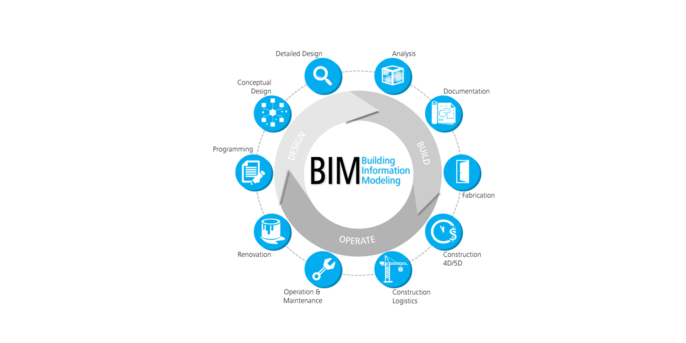10. March 2021 By Uwe Lutter
Digitalisation becomes part of the toolbox, Part 1 – Building information modelling
The construction industry in Germany provides work for approximately two million employees and is home to around 330,000 businesses, making it one of the country’s most important economic sectors. Of course, it gives pause for thought that when it comes to the use of digital technologies and processes, the construction industry is lagging far behind nearly every other industry. According to a study by McKinsey, while the Germany economy overall has recorded an average annual productivity growth of 1.32 per cent over the last 15 years, the annual productivity growth in the construction industry was just 0.26 per cent.
The construction industry has stuck to traditional planning and construction processes for quite some time. At best, IT systems were used to replicate traditional and manual methods 1:1 in software programs. CAD sends its regards! The industry is now, however, finally reconsidering its approach. Most construction companies now believe that digital innovation is not only an option for them, but one they cannot afford not to take. According to a study by the Association of German Chambers of Industry and Commerce (Deutsche Industrie- und Handelskammertag), 93 per cent of construction companies agree that digitalisation will influence their processes in their entirety. This demonstrates that companies are aware that the megatrend of digitalisation must lead to a comprehensive realignment of a great number of processes in the industry. What is still missing is implementation.
But what changes can we expect in the next few years?
For one, using digital innovations directly on the construction site can lead to significantly more productive manufacturing processes. Robots are already being tested that can build walls brick by brick. 3D printing is already being used to produce masonry and shuttering. Machines used on the construction site – think of excavators or bulldozers – will become more autonomous and efficient in the future, controlled by GPS.
In addition, there is enormous potential in restructuring and redesigning construction planning and control processes with the help of IT. This cannot be overestimated, especially for Germany with its extremely fragmented construction industry – it’s not uncommon for more than 100 subcontractors to be involved in a single construction project. Ultimately, the aim is to make the coordination and cooperation of all the companies involved in a construction project more transparent and interactive. All parties involved in the project need to have constant access to the information relevant to them. In this way, planning errors, coordination problems and the resulting costly building defects can be prevented.
This is where building information modelling, or BIM for short, steps in to facilitate the networked planning and execution of construction projects. The German Federal Ministry of Transport and Digital Infrastructure (Bundesministerium für Verkehr und digitale Infrastruktur, BMVI) is a key driver of the digitalisation of the construction industry in Germany and defines BIM as follows:
‘Building information modelling refers to a collaborative working methodology that uses digital models of a structure to consistently capture and manage information and data relevant to its life cycle, and to share and hand it over for further processing in a transparent communication between stakeholders.’

The 3D model of the planned structure is at the heart of BIM. BIM requires that this model be accessible to all of the participating companies at an early stage from a software perspective so that they can continue to develop it within the context of their trade and, if necessary, enrich it with additional information. Unfortunately, this is often not how the process unfolds nowadays. Many IT systems used for construction planning work with proprietary data formats and force the users into their microcosm. These formats are then incompatible with other manufacturers’ systems, which often leads to information arriving late or being incorrect and ultimately to expensive delays and errors.
BIM – sometimes also openBIM – pushes companies to share 3D models in a neutral data format. This is where industry foundation classes (IFC) come in. IFC is already supported by many popular software systems as a format for storing and exchanging 3D model information and is the official ISO standard in its current IFC4 version.
More than a uniform 3D model
However, BIM goes far beyond the use of a unified 3D model. Construction projects carried out according to BIM supplement the 3D model with the scheduling of construction activities. Thanks to the dimension of time being added, the 3D model becomes an IFC 4D model, which, for example, makes it possible to run interactive simulations of how the construction process will play out. Adding quantity and cost information to the model as a further dimension creates a 5D model according to BIM, which then allows you to forecast how the costs will develop over the entire duration of the project. Other BIM dimensions – 6D and 7D – represent sustainability planning and operational information (facility management).
The BIM manager is responsible for planning and monitoring the BIM process. They decide on the specific design of the BIM process for the construction project and define which specialist planners have to create which 3D models. The manager bases their specifications on the customer’s requirements for the BIM process specified in the customer information requirements (Auftraggeber-Informationsanforderungen, AIA). BIM also introduces the role of the BIM coordinator, who takes care of implementing the BIM goals on the IT side. For this purpose, they usually use a digital platform, called the common data environment (CDE), to store and share information and models relating to the construction project.
What has already been achieved through BIM
In Germany, the introduction of BIM is being promoted and driven forward to a large extent by customers from the public sector. For this reason, the German Federal Ministry of Transport and Digital Infrastructure has published the Road Map for Digital Design and Construction. The road map stipulates that all construction projects in the BMVI’s area of responsibility from 2020 onwards must be carried out according to BIM and meet a defined minimum standard. An essential point of this standard is the sharing of data between the project partners in a construction project across systems by using neutral data formats. To this end, a common data environment must be created to store and share the data generated in the planning and construction process in an organised way and without loss, and to ensure access by all those involved.
2019 marked another milestone with the founding of the National BIM Centre of Excellence. The contract for planning and operation was awarded to planen-bauen 4.0 GmbH. The Centre of Excellence will support the German federal government in achieving the following goals:
- Development and implementation of a uniform standardisation and open BIM strategy.
- Development of requirements and benchmarks for construction projects.
- Preparation of initial training and continuing professional development schemes.
- Establishment and maintenance of a BIM portal with a database, verification tools and BIM objects.
- Development of a BIM strategy in the operation of federal government property.
- Development of a strategy for the next steps after 2020.
The development of the BIM portal is one of several projects that adesso is currently carrying out together with planen bauen 4.0. I’ll get into that in the second part of my blog post.
Would you like to learn more about exciting topics from the world of adesso? Then check out our latest blog posts.

